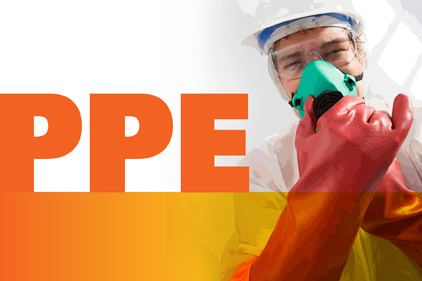Hand protection
No glove may be used as protection from all chemicals

 A glove may protect against a specific chemical, but it may not protect the wearer from another. If a glove protects the wearer, it will not protect the wearer forever, as the glove material will deteriorate. Therefore, the following must be considered when choosing which gloves to be worn to protect against chemical exposures.
A glove may protect against a specific chemical, but it may not protect the wearer from another. If a glove protects the wearer, it will not protect the wearer forever, as the glove material will deteriorate. Therefore, the following must be considered when choosing which gloves to be worn to protect against chemical exposures.
Factors to consider when choosing gloves
- Chemical to be used: Consult the compatibility charts to ensure that the gloves will protect you.
- Dexterity needed: The thicker the glove, typically the better the chemical protection, as the glove will be more resistant to physical damage, like tears and cracks, but it will be harder to handle and feel the work.
- Extent of the protection required: Determine if a wrist length glove provides adequate protection, or will a glove that extends further up the arm be required.
- Type of work to be done: Gloves are specific to the task. Ensure the correct glove is chosen to avoid injuries. Examples: A nylon cryogenic glove will be damaged if a hot item is handled, where as a “hot mitt” will not protect the wearer when liquid nitrogen is used, as it may be too porous.
Rules for glove use in the labs
- Wear the correct gloves when needed.
- Wear gloves no longer than 2 hours.
- Wash hands once gloves have been removed.
- Disposable gloves must be discarded once removed. Do not save for future use.
- Dispose of gloves into the proper container (biologically contaminated gloves will need to go into a red bag); while other chemically contaminated gloves may not.
- Non-disposable/reusable gloves must be washed and dried, as needed, and then inspected for tears and holes prior to reuse.
- Remove gloves before touching personal items, such as phones, computers, pens and one’s skin. Remember the “designated area rule” where “science” does not mix with personal space (one’s desk or lunch space). Gloves used in research are considered “science”.
- Do not wear gloves out of the lab. If gloves are needed to transport anything, wear one glove to handle the transported item. The free hand is then used to touch door knobs, elevator buttons, etc. If you are wearing gloves to “protect your sample from you” and are in the hall, no one else understands this and will be concerned about the items you have contaminated with those gloves.
- If for any reason a glove fails, and chemicals come into contact with skin, consider it an exposure and seek medical attention.
Understanding terms used in glove compatibility charts:
- Breakthrough time: Time it takes for the chemical to travel through the glove material. This is only recorded at the detectable level on the inside surface of the glove.
- Permeation Rate: Time it takes for the chemical to pass through the glove once breakthrough has occurred. This involves the absorption of the chemical into the glove material, migration of the chemical through the material, and then deabsorption once it is inside the glove.
- Degradation rating: This is the physical change that will happen to the glove material as it is affected by the chemical. This includes, but is not limited to swelling, shrinking, hardening, cracking, etc. of the glove material.
Compatibility charts’ rating systems will vary by the manufacturer’s design of their chart. Many use a color code, where red = bad, yellow = not recommended, green = good, or some variation this scheme. A letter code may be used, such as E + excellent, G = Good, P = poor, NR = Not Recommended. Any combination of these schemes may be used, so please understand the chart before making a decision on the glove to be used.
Source: EHS Department at the University of Florida
Looking for a reprint of this article?
From high-res PDFs to custom plaques, order your copy today!





